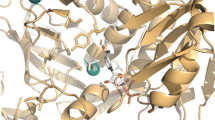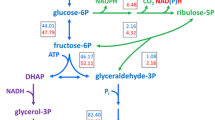Abstract
Saccharomyces cerevisiae alcohol dehydrogenases responsible for NADH-, and NADPH-specific reduction of the furaldehydes 5-hydroxymethyl-furfural (HMF) and furfural have previously been identified. In the present study, strains overexpressing the corresponding genes (mut-ADH1 and ADH6), together with a control strain, were compared in defined medium for anaerobic fermentation of glucose in the presence and absence of HMF. All strains showed a similar fermentation pattern in the absence of HMF. In the presence of HMF, the strain overexpressing ADH6 showed the highest HMF reduction rate and the highest specific ethanol productivity, followed by the strain overexpressing mut-ADH1. This correlated with in vitro HMF reduction capacity observed in the ADH6 overexpressing strain. Acetate and glycerol yields per biomass increased considerably in the ADH6 strain. In the other two strains, only the overall acetate yield per biomass was affected. When compared in batch fermentation of spruce hydrolysate, strains overexpressing ADH6 and mut-ADH1 had five times higher HMF uptake rate than the control strain and improved specific ethanol productivity. Overall, our results demonstrate that (1) the cofactor usage in the HMF reduction affects the product distribution, and (2) increased HMF reduction activity results in increased specific ethanol productivity in defined mineral medium and in spruce hydrolysate.




Similar content being viewed by others
References
Alkasrawi M, Rudolf A, Lidén G (2006) Influence of strain and cultivation procedure on the performance of simultaneous saccharification and fermentation of steam pretreated spruce. Enzyme Microb Technol 38:279–287
Almeida JRM, Modig T, Petersson A, Hahn-Hägerdal B, Lidén G, Gorwa-Grauslund MF (2007) Increased tolerance and conversion of inhibitors in lignocellulosic hydrolysates by Saccharomyces cerevisiae. J Chem Technol Biotechnol 82:340–349
Banerjee N, Bhatnagar R, Viswanathan L (1981) Inhibition of glycolysis by furfural in Saccharomyces cerevisiae. Appl Microbiol Biotechnol 11:226–228
Carmel-Harel O, Storz G (2000) Roles of the glutathione- and thioredoxin-dependent reduction systems in the Escherichia coli and Saccharomyces cerevisiae responses to oxidative stress. Annu Rev Microbiol 54:439–461
Gorsich SW, Dien BS, Nichols NN, Slininger PJ, Liu ZL, Skory CD (2006) Tolerance to furfural-induced stress is associated with pentose phosphate pathway genes ZWF1, GND1, RPE1, and TKL1 in Saccharomyces cerevisiae. Appl Microbiol Biotechnol 71:339–349
Hauf J, Zimmermann FK, Muller S (2000) Simultaneous genomic overexpression of seven glycolytic enzymes in the yeast Saccharomyces cerevisiae. Enzyme Microb Technol 26:688–698
Heux S, Cachon R, Dequin S (2006) Cofactor engineering in Saccharomyces cerevisiae: Expression of a H2O-forming NADH oxidase and impact on redox metabolism. Metab Eng 8:303–314
Karhumaa K, Hahn-Hägerdal B, Gorwa-Grauslund MF (2005) Investigation of limiting metabolic steps in the utilization of xylose by recombinant Saccharomyces cerevisiae using metabolic engineering. Yeast 22:359–368
Laadan B, Almeida JR, Rådström P, Hahn-Hägerdal B, Gorwa-Grauslund MF (2008) Identification of an NADH-dependent 5-hydroxymethylfurfural-reducing alcohol dehydrogenase in Saccharomyces cerevisiae. Yeast 25:191–198
Larroy C, Fernandez MR, Gonzalez E, Pares X, Biosca JA (2002) Characterization of the Saccharomyces cerevisiae YMR318C (ADH6) gene product as a broad specificity NADPH-dependent alcohol dehydrogenase: relevance in aldehyde reduction. Biochem J 361:163–172
Linden T, Peetre J, Hahn-Hägerdal B (1992) Isolation and characterization of acetic acid-tolerant galactose-fermenting strains of Saccharomyces cerevisiae from a spent sulfite liquor fermentation plant. Appl Environ Microbiol 58:1661–1669
Liu ZL, Slininger PJ, Dien BS, Berhow MA, Kurtzman CP, Gorsich SW (2004) Adaptive response of yeasts to furfural and 5-hydroxymethylfurfural and new chemical evidence for HMF conversion to 2,5-bis-hydroxymethylfuran. J Ind Microbiol Biotechnol 31:345–352
Michnick S, Roustan J-L, Remize F, Barre P, Dequin S (1997) Modulation of glycerol and ethanol yields during alcoholic fermentation in Saccharomyces cerevisiae strains overexpressed or disrupted for GPD1 encoding glycerol 3-phosphate dehydrogenase. Yeast 13:783–793
Modig T, Liden G, Taherzadeh MJ (2002) Inhibition effects of furfural on alcohol dehydrogenase, aldehyde dehydrogenase and pyruvate dehydrogenase. Biochem J 363:769–776
Modig T, Almeida JRM, Gorwa-Grauslund MF, Lidén G (2008). Variability of the response of Saccharomyces cerevisiae strains to lignocellulose hydrolysate. Biotech Bioeng (in press) DOI https://doi.org/10.1002/blt.21789
Nilsson A, Taherzadeh MJ, Liden G (2001) Use of dynamic step response for control of fed-batch conversion of lignocellulosic hydrolyzates to ethanol. J Biotechnol 89:41–53
Nilsson A, Gorwa-Grauslund MF, Hahn-Hägerdal B, Liden G (2005) Cofactor dependence in furan reduction by Saccharomyces cerevisiae in fermentation of acid-hydrolyzed lignocellulose. Appl Environ Microbiol 71:7866–7871
Palmqvist E, Hahn-Hägerdal B (2000) Fermentation of lignocellulosic hydrolysates. II: inhibitors and mechanisms of inhibition. Bioresour Technol 74:25–33
Petersson A, Almeida JRM, Modig T, Karhumaa K, Hahn-Hägerdal B, Gorwa-Grauslund MF, Liden G (2006) A 5-hydroxymethyl furfural reducing enzyme encoded by the Saccharomyces cerevisiae ADH6 gene conveys HMF tolerance. Yeast 23:455–464
Remize F, Roustan JL, Sablayrolles JM, Barre P, Dequin S (1999) Glycerol overproduction by engineered Saccharomyces cerevisiae wine yeast strains leads to substantial changes in by-product formation and to a stimulation of fermentation rate in stationary phase. Appl Environ Microbiol 65:143–149
Rudolf A, Alkasrawi M, Zacchi G (2005) A comparison between batch and fed-batch simultaneous saccharification and fermentation of steam pretreated spruce. Enzyme Microb Technol 37:195–205
Schneider R, Brors B, Burger F, Camrath S, Weiss H (1997) Two genes of the putative mitochondrial fatty acid synthase in the genome of Saccharomyces cerevisiae. Curr Genet 32:384–388
Taherzadeh MJ, Gustafsson L, Niklasson C, Liden G (1999) Conversion of furfural in aerobic and anaerobic batch fermentation of glucose by Saccharomyces cerevisiae. J Biosci Bioeng 87:169–174
Taherzadeh MJ, Gustafsson L, Niklasson C, Liden G (2000a) Inhibition effects of furfural on aerobic batch cultivation of Saccharomyces cerevisiae growing on ethanol and/or acetic acid. J Biosci Bioeng 90:374–380
Taherzadeh MJ, Gustafsson L, Niklasson C, Liden G (2000b) Physiological effects of 5-hydroxymethylfurfural on Saccharomyces cerevisiae. Appl Microbiol Biotechnol 53:701–708
van Dijken JP, Scheffers WA (1986) Redox balances in the metabolism of sugars by yeasts. FEMS Microbiol Lett 32:199–224
van Dijken JP, Bauer J, Brambilla L, Duboc P, Francois JM, Gancedo C, Giuseppin ML, Heijnen JJ, Hoare M, Lange HC, Madden EA, Niederberger P, Nielsen J, Parrou JL, Petit T, Porro D, Reuss M, van Riel N, Rizzi M, Steensma HY, Verrips CT, Vindelov J, Pronk JT (2000) An interlaboratory comparison of physiological and genetic properties of four Saccharomyces cerevisiae strains. Enzyme Microb Technol 26:706–714
Verduyn C, Postma E, Scheffers WA, Van Dijken JP (1992) Effect of benzoic acid on metabolic fluxes in yeasts: a continuous-culture study on the regulation of respiration and alcoholic fermentation. Yeast 8:501–517
Acknowledgments
This work was sponsored by the Swedish Energy Agency and the Swedish Foundation for International Cooperation in Research and Higher Education. We would like to thank Prof. Bärbel Hahn-Hägerdal for critically reading the manuscript.
Author information
Authors and Affiliations
Corresponding author
Rights and permissions
About this article
Cite this article
Almeida, J.R.M., Röder, A., Modig, T. et al. NADH- vs NADPH-coupled reduction of 5-hydroxymethyl furfural (HMF) and its implications on product distribution in Saccharomyces cerevisiae . Appl Microbiol Biotechnol 78, 939–945 (2008). https://doi.org/10.1007/s00253-008-1364-y
Received:
Revised:
Accepted:
Published:
Issue Date:
DOI: https://doi.org/10.1007/s00253-008-1364-y




